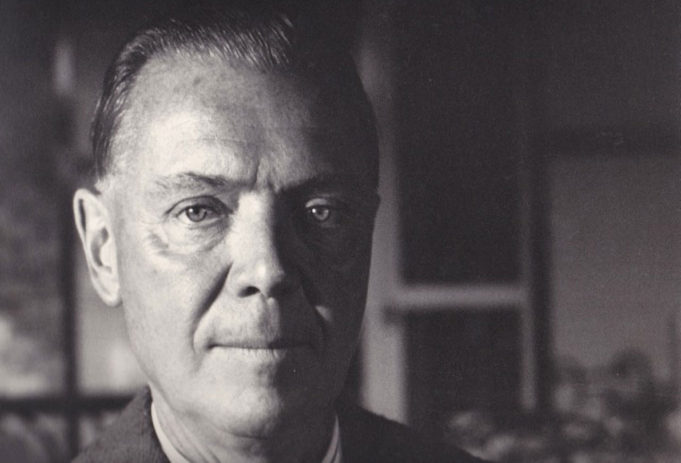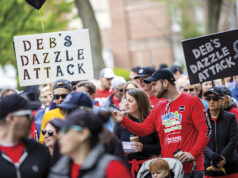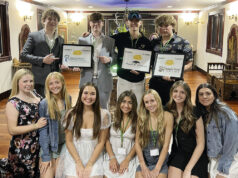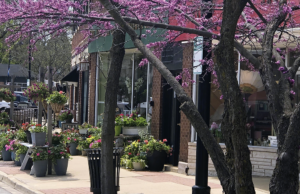the father of Oak Brook… and much more
By Larry Atseff
Once upon a time, spanning much of the 20th century, a true visionary came on the scene in what is now the Village of Oak Brook. Paul Butler was the Father of Oak Brook—but he accomplished a whole lot more. What follows is a reminder of some of what he did, and how he did it all. Karen Bushy, the last president of Oak Brook to know and spend time with Butler, has contributed many of the observations in this piece. Bushy was a person that Butler trusted during the years when his ideas were being translated into reality, as the dream began to be implemented on the scale he had imagined. Bushy met Butler shortly after moving to Oak Brook in 1973. They became good friends and remained so for the rest of Butler’s life.
The Butler Paper Company
Before there was a Paul Butler, there was the Butler Paper Company. Butler’s grandfather Julius Wales Butler and great uncle Oliver Morris Butler founded the J.W. Butler Paper Co. in the 1800s in the Chicago area. It grew to become one of the largest family-owned paper companies in the country until Paul Butler sold it in 1960. Nevertheless, Butler Paper was the foundation that enabled Butler to add companies and follow pursuits in a number of eclectic directions. Paul Butler arrives on the scene Tom and Mary Sterling, authors of Hinsdale & the World, relate that Butler was born on June 23, 1892 to Frank and Fannie Butler of Hinsdale, owners of the Butler Paper Co. “When Paul and his brother, Julius, were still children, their father bought land on the west bank of Salt Creek as the site for their future home,” the Sterlings write. “The tall oaks surrounding the area together with the babbling brook gave it the name later shared with an entire village—Oak Brook. Frank Butler’s Oak Brook was a farmhouse like any other, consisting of a house, stables, and fields. When Frank bought nearby Natoma Dairy from George Robbins, son of Hinsdale’s founder William Robbins, he acquired Natoma’s lucrative dairy operation along with its fine herd of prize-winning dairy cows. The name Natoma, by the way, comes from the Indian word meaning ‘running water,’ no doubt a reference to Salt Creek. When Paul eventually acquired Natoma Farm from his father, he used it as headquarters for both the Butler Co. and his sports core, as he began systematically to develop the area.”
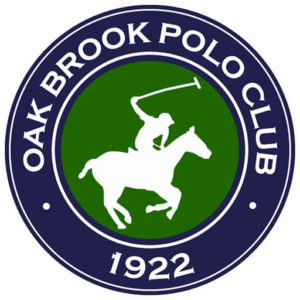 The influence of polo and horsemanship
The influence of polo and horsemanship
According to a biography by the Oak Brook Polo Club, Butler attended the University of Illinois from 1910 to 1911, where he studied agriculture. He also served as a lieutenant in the 106th cavalry, which was known as the Black Horse Troop during the First World War. He also became a captain and a pilot during the war. After serving, he also spent time on Butler ranches in the Dakota territory and oversaw Montana ranches in the 1940s. “The game of polo captured the heart of Paul Butler, whose enthusiasm for the game would shape the evolution of a village,” the Sterlings say. “As a member of the Wheaton polo team, in 1915, young Paul Butler helped lead his team to victory over a team from Onwentsia. His love for the game led to the creation of the Oak Brook Polo Club, and, in 1929, organizers put him in charge of setting up polo matches for the 1933 Chicago World’s Fair, which hoped to feature ‘games of every sport from archery to polo…with the greatest athletes from all nations competing.’”When he played actively, he won six U.S. Open Polo Championships and four Butler Handicap titles, according to the biography. Polo provided the Village of Oak Brook a lifestyle appeal—a social sporting scene, attracting people from across the country and polo teams from around the world. In many ways, polo created what became Oak Brook. The Oak Brook Polo Club was the largest polo plant in the world from 1954 to 1979, and would be billed the “polo capital of the United States,” or “polo town.” Not only did the club host polo every week during the season, but it also “rode to the hounds” in full regalia with regularity. By 1956, the Oak Brook Polo Club had 14 polo fields and stabling for 400 horses, with games, played six days a week during the season. The club also included grandstands, bleachers and box seats, a clubhouse, and 36 miles of tree-lined trails. Butler joined the two polo fields closest to Oak Brook Road (31st Street) and York Road so they could be used as an airstrip for incoming guests. Those guests included royalty, dignitaries, celebrities, and professional golfers, who loved playing at Butler National Golf Club. Over the years, Prince Charles, Lord Cowdray, Maj. Ronald Ferguson, Lord Patrick Beresford, King Hussein, the Maharaja and Maharani of Jaipur, Audrey Hepburn, Vivien Leigh, and others visited the club. Mick Jagger was a frequent guest, as was Susan St. James. Butler’s Oak Brook team also traveled far and wide to support other clubs, and Oak Brook hosted international teams from Argentina, Mexico, England, and India.

Butler’s approach to business and Oak Brook
As noted, Karen Bushy moved into the village in 1973 and got to know Butler and his family as neighbors. What follows are her recollections about how Paul Butler worked with neighbors and others who could help him realize the dream of a special Oak Brook and other successes. She says, “If you lived in Oak Brook, Butler considered you a ‘neighbor’. His friend and then village president George Howell had named Bushy to the plan commission, and Butler loved the idea that young people moving into the village were eager to catch his vision for what this could become. He gladly shared with those who cared to participate in what he called his ‘grand experiment’.” “For Paul, it just made straightforward, practical sense to him to work where he lived,” Bushy said. “His polo operations were right nearby. He loved the surroundings—the trees, the water, and the earth itself—the reason the Oak Brook Polo Club colors were blue and green with a bit of brown accent. Here he could meet with his nearby friends, farmers, and landowners. One of the low-slung, rather unremarkable buildings that were part of the old dairy operation was actually the general headquarters for all of the farflung Butler enterprises and interests. Known locally as ‘the GHQ,’ it was where Paul and others had their office—offices that were very, very casual: blue jeans and boots—never suits and ties, to be sure.” Bushy said the GHQ contained a conference room that Butler called the “chart room.” One whole wall was covered with an aerial photograph of the Butler landholdings in the area, allowing Paul and those there to do business with him a chance to really appreciate the “big picture.” Two of the people there helped keep Paul “on track,” secretary Ann Spurrier, and his “houseman” Kenyon. “His larger vision beyond polo and riding to hounds was to develop more activities at the sports core,” Bushy said. “He had the land and thought it could be turned into a world-class golf course. And so in 1972, Butler National Golf Club was created.” Butler National hosted the Western Open from 1974 to 1990, and in May 2007, Golf Digest rated Butler No. 21 on its list of “America’s 100 Greatest Courses.”
She recalls, “In the same compound as the GHQ, folks from Oak Brook and others who knew it was there enjoyed one of the best restaurants around: The Oak Brook Saddle Club. Known for its ‘best available steaks’, and even more for the neighborly camaraderie, Friday and Saturday nights you could always find friends and neighbors enjoying drinks and dinner at the Saddle Club, an atmosphere that grew over time, to be sure. You just had to know where to turn off on to the gravel road that led deep into the woods.” Elsewhere on the “sports core” property, Butler had built the Oak Brook Bath & Tennis Club, a membership-only place for summer rest and relaxation and a lovely amenity to the polo operations, along with a small nine-hole executive golf course he’d built on the property. It became the site for the Sunday afternoon parties after the conclusion of the last polo game of the day. Bushy said Butler “almost always” enjoyed a good relationship with local residents. “As they saw how he was developing the area, they looked to him when they wanted to sell their farmland,” she said. “Eventually, Butler Co. owned 3,600 acres in the area, simply by offering to buy their land when they wanted to sell. He interacted frequently with the neighbors, who had formed the Oak Brook Civic Association.” An important quality about Butler that Bushy noted was his willingness to change his mind when he realized he made a mistake. For example, as companies moved their headquarters out to Oak Brook, he was adamant that the buildings be only one or two stories, square, boxy and white. After a few went up, he admitted it was a “terrible idea”. Polo activities and ranch holdings took Butler all over the country. That’s where his training as a pilot came in handy, enabling him to fly to often remote locations. Ever curious and observant, Butler noted that all these small airports had the same needs in terms of equipment, fuel, buildings and hangars, and so Butler Aviation was born.
“The beauty of the open fields, the magnificent stands of old-growth oak forests, were to be preserved for the future, so he worked with George Howell, and they crafted an agreement to sell the sports core to the people of Oak Brook, provided the land would ‘in perpetuity be green space, owned by and for the benefit of the people of the Village of Oak Brook.’ That preserved another 270 acres in the center of the village.”
In 1986, Paul sold Butler Aviation to North American Ventures for $140 million in cash and stock. The company, based in Montvale, N.J., grew to provide technical and management services to airports, marine, energy, electronics and telecommunications, employing 10,000 people with estimated revenues of $400 million. By the time Bushy got to know Butler in the ‘70s, he had developed three major subdivisions in the village: Ginger Creek, York Woods, and Brook Forest. Butler never wanted to build the homes; instead, his focus was on the land and keeping everything as natural as possible. Starting with so much raw land, much of it wooded and rolling, Butler was able to implement his vision on a grand scale. Lot sizes would be substantial. Homes would be set back from the roadway and generous separation between the homes was expected, for both privacy and beauty. He wanted the land to be left just as nature created it. There would be no leveling of hills and dales, no straight roads and streets. Instead, there would be winding roads and paths, following the natural contours of the land. The residents who would become the decision-makers for the village understood his goals and his vision, and they were the ones who implemented those ideas and codified them into what became known as the subdivision control ordinance that governed all aspects of development in Oak Brook. “His eager collaboration with those who lived here and who were willing to devote their time to giving life to his dreams made for a beautiful, forward-looking village,” Bushy said.
Concerned with the encroachment of the suburbs, Butler also consulted with several experts to complete a comprehensive plan for Oak Brook. The idea was to work out a plan for a well-organized commercial area that would support the homes and recreational areas. His vision was a village of no more than 10,000 residents. In the same vein, Butler wanted to make sure that there would be plenty of natural land settings throughout Oak Brook. He donated the land that would become a large tract of forest preserve, which adjoins Fullersburg Woods to the south in Hinsdale. The side of the preserve facing 31st Street has been named Paul Butler Nature Area. Butler also donated land for what would become Christ Church of Oak Brook. He hoped for a large church that would welcome all who came to Oak Brook. He thought that more appropriate than several small denominational churches. In the years when the Western Open was hosted in the village and international polo was being played throughout the summer, another of his ideas manifested: golfers, broadcasters, polo players, and fans alike all found a place to worship in town, alongside the “local folks.” Butler further donated land for schools, and was involved with his father and uncle in building both the first and second Butler School. The original school at Spring Road and 31st Street is now the home of the Oak Brook Historical Society. “Paul did not want there to ever be development on his beloved sports core,” Bushy said. “The beauty of the open fields, the magnificent stands of old growth oak forests, were to be preserved for the future, so he worked with George Howell, and they crafted an agreement to sell the sports core to the people of Oak Brook, provided the land would ‘in perpetuity be green space, owned by and for the benefit of the people of the Village of Oak Brook.’

That preserved another 270 acres in the center of the village.” “Part of Butler’s vision was attracting businesses to the area to create a tax base. The fanfare of sporting activities was a natural springboard for contacts for bringing business headquarters out to Oak Brook. Companies were quick to recognize the ingenuity of Butler’s plan, which meant that property owners in the village, both residential and commercial, would pay no property taxes to operate the village. All of the revenues needed to sustain operations came from sales tax producing commercial enterprises, which the business community greatly appreciated. All of this made Oak Brook even more attractive for companies to relocate.” “As residential and commercial development evolved, Oak Brook was incorporated in 1958, and in the early 1960s, Oakbrook Center was developed into as a very desirable upscale shopping mall.”
Paul Butler’s children
Paul had four children: Michael, Jorie, Frank, and Norman. Michael and Jorie followed in their father’s footsteps in their own way. As you might expect, with all of his contacts with notables through Polo and his many pursuits, Paul found time and interest to back a number of successful Broadway shows including Kismet, Peter Pan, and The Music Man. Paul’s son Michael followed his father by promoting the sport of polo, volunteering his talents to the US Polo Association, and supported the arts. In fact, Michael became an American theatrical producer best known for bringing the rock musical Hair from the public theater to Broadway in 1968. His daughter Jorie, became an excellent rider and polo player herself and was rated by the US Polo Association in 1969. She organized the USPA Polo Pony Championship and helped establish its rules and registry. She served on the board of directors for the National Polo Museum and the Hall of Fame selection committee. Jorie also developed the Hunter Trails subdivision. In 1971, she married Geoffrey Kent. He too was a polo player, and with him, she helped build a very successful travel business specializing in luxury photography safaris all over the world. Like her dad, she is also very committed to conservation efforts.
Last Observations
One of Paul Butler’s many passions was photography. Each year, he would select a photograph he’d taken, and have it made into a Christmas card that was sent to every home in the village. Sharing what he loved about nature and Oak Brook was important to him, and he hoped others would enjoy it and appreciate it as much as he did. In a terrible irony, on June 21, 1981, he was standing in the middle of Oak Brook Road, right in front of his old homestead, taking photographs of the sunset, when he was struck by a car and killed. Almost 30 years have passed since that date—enough time to see how many of his innovative ideas have become the accepted standard in so many of the areas he influenced. “Paul Butler was a true visionary, a true Renaissance man,” Bushy said, “not only the Father of Oak Brook, but even more than you ever imagined.”
*Photos provided by the city of Oak Brook


